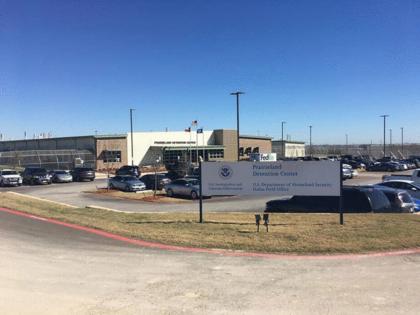What we know about Prairieland, the Texas ICE detention center where officers were ambushed on July 4
Published in News & Features
Tensions over the federal government’s immigration agenda erupted into violence 25 miles from downtown Fort Worth, Texas, last week.
A group of 10 to 12 people ambushed corrections and police officers outside the Prairieland Detention Center in Alvarado, Texas, on July 4, creating a distraction with fireworks and graffiti before firing upon officers with semiautomatic rifles.
One Alvarado police officer was hit in the neck. He was airlifted to a Fort Worth hospital, where he was treated and released. Federal prosecutors on Monday charged 11 suspects with attempted murder and weapons charges.
Before the attack, many in the area were likely completely unaware that the facility was so close to home. When did Prairieland open, how many detainees is it built to hold and what are the conditions like inside?
Here’s what we know about the ICE detention center in Fort Worth’s backyard.
Prairieland opened at the beginning of the first Trump administration
Prairieland opened in 2017. It was built to house 707 detainees, according to the Dallas-based immigration firm Chavez & Valko.
ICE did not respond to multiple requests for a tour of the detention center or questions sent via email.
Prairieland’s proximity to the Dallas area makes it more accessible for lawyers representing clients detained there, the Chavez & Valko site states. The other three facilities in the operations area of ICE’s Dallas field office are in Anson, Eden and Haskill, at least a 3-hour drive west of the Metroplex.
The facility spurred controversy as soon as beds began to be filled because of its dedicated transgender ward. Three dozen beds are in a separate area reserved for transgender detainees. Prairieland was the second such facility in the country when it opened, according to The Guardian.
LGBTQ+ advocates who spoke to The Guardian the week it opened expressed concerns that the separate facilities for transgender detainees would lead to isolation and make them targets for abuse.
Paul Hunker, a Dallas-based immigration lawyer who previously worked as chief counsel for ICE, said the idea was to protect transgender detainees, but he thinks the ward is no longer in use.
“It didn’t last very long,” he said in an interview. “I don’t believe there’s any special transgender detention there.”
What are conditions like in the Prairieland Detention Center?
People who have been detained in Prairieland have described an overcrowded, unsanitary space.
One Afghan national who spoke to the Star-Telegram via phone from within the facility in March said he was with around 100 other men in a room meant for 60. Extra mattresses were spread out on the floor to accommodate the detainees.
Ward Sakeik, an Arlington resident who was released from Prairieland last week, told reporters at a press conference that this and the other two ICE detention facilities she was housed in were unsanitary.
Not recognized as a citizen of any country, Sakeik is stateless and married to a U.S. citizen. She was detained at the airport in Miami on her way back to Texas from her honeymoon in the U.S. Virgin Islands.
“The conditions of these facilities are terrible, extremely unhygienic, dust everywhere” she said. “The restrooms are also very, very, very much unhygienic. The beds have rust everywhere. They’re not properly maintained. And cockroaches, grasshoppers, spiders, you name it, all over the facility.”
Women she was housed with became sick because of these conditions, she said, and would wake up with bug bites and bruises.
There was also very little to do, she said, adding she would try to fill the day’s 24 hours with reading and coloring. Guards at the facility where she was before Prairieland provided her and her fellow detainees with workout and Zumba CDs so they could move around, for which she was very grateful.
The Star-Telegram reached out to Sakeik for more details on specific conditions in Prairieland. Her husband Taahir Shaikh said she would politely decline, as she is taking time to rest after her experience.
Compared to other federal immigration detention centers, Prairieland is in better condition, said Hunker, the Dallas immigration lawyer. He used to compare it to one that is no longer in operation in Okmulgee, Oklahoma, by saying if the latter was a Motel 6 of ICE detention, “then Prairieland was the J.W. Marriott.”
“Obviously no one likes to be detained, but as far as federal detention centers go, I thought it was a good, safe, humane detention center,” he said. “I was proud of it when I was with ICE.”
Hunker has visited the center and has one client there now. He declined to give more information about his client’s experience, but said the person has “no real complaints.”
As far as overcrowding, with over 56,000 people in ICE detention as of June 15, according to the Transactional Records Access Clearinghouse, a nonprofit research organization at Syracuse University, Hunker said it’s likely space is tight in Prairieland.
“I’ve heard in other detention centers that people are really crowded in there,” he said. “I assume that’s the case for Prairieland, too.”
_____
©2025 Fort Worth Star-Telegram. Visit star-telegram.com. Distributed by Tribune Content Agency, LLC.







Comments